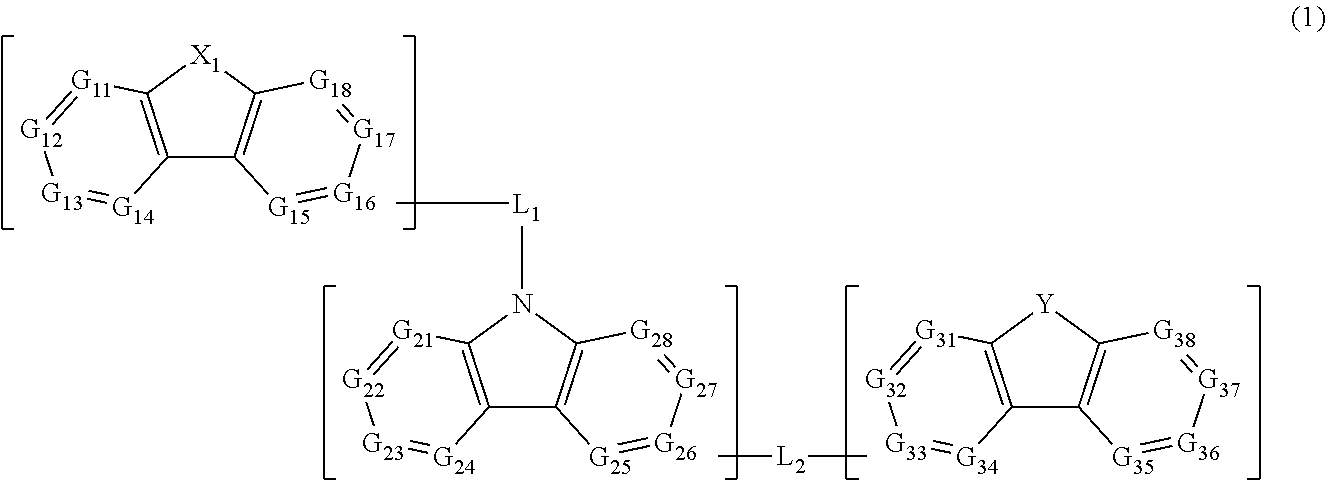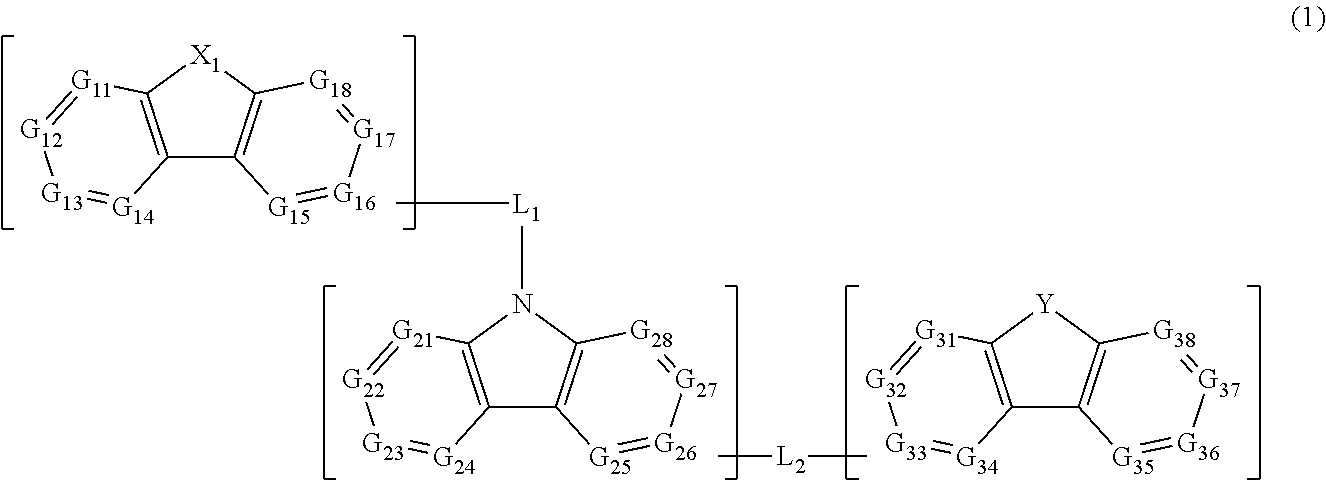Material for organic electroluminescent elements, and organic electroluminescent element using same
- Summary
- Abstract
- Description
- Claims
- Application Information
AI Technical Summary
Benefits of technology
Problems solved by technology
Method used
Image
Examples
##eses example 1
Syntheses Example 1
Synthesis of Compound (1)
(1) Synthesis of Compound (1-a)
[0241]
[0242]Into a three-necked flask, 100.1 g (575 mmol) of 2-bromo-3-hydroxypyridine, 88.5 g (632.5 mmol) of 2-fluorophenylboronic acid, 88.5 g (2300 mmol) of potassium carbonate, 1150 ml of N,N-dimethylacetamide, and 13.3 g (11.5 mmol) of Pd(PPh3)4 were charged. In nitrogen atmosphere, the mixture was stirred under heating at 90° C. for 12 h and further stirred under heating at 160° C. for 8 h.
[0243]After the reaction, the reaction solution was cooled to room temperature and then added with 1 L of toluene and 1 L of water. The resultant liquid was vigorously shaken in a separating funnel. After separating the toluene phase, the water phase was extracted by several portions of toluene. The obtained toluene solution was washed with water several times, dried over anhydrous magnesium sulfate, passed through a short column of silica gel, and then, concentrated. The obtained product was recrystallized from 200 ...
##eses example 2
Syntheses Example 2
Synthesis of Compound (2)
(1) Synthesis of Compound (2-a)
[0253]
[0254]Into a three-necked flask, 48.1 g (240 mmol) of 4,4′-diaminodiphenyl ether, 149.4 g (528 mmol) of 2-bromoiodobenzene, 92.3 g (960 mmol) of tert-BuONa, 2.2 g (2.4 mmol) of Pd2(dba)3, 2.66 g (4.8 mmol) of 1,1′-bis(diphenylphosphino)ferrocene, and 960 ml of toluene were charged. The mixture was refluxed for 8 h in nitrogen atmosphere.
[0255]After the reaction, the reaction liquid was added with 500 ml of water and then extracted with several portions of ethyl acetate in a separating funnel. The extract was dried over anhydrous magnesium sulfate, filtered, and concentrated. The concentrate was purified by silica gel chromatography (toluene:hexane=3:7) to obtain a colorless viscous matter.
[0256]The identification of the compound was made by 1H-NMR and FD / MS molecular weight measurement. The yield was 109.68 g and the percentage yield was 90%.
(2) Synthesis of Compound (2-b)
[0257]
[0258]Into a three-necked...
synthesis example 3
Synthesis of Compound (3)
(1) Synthesis of Compound (3-a)
[0263]
[0264]Into a three-necked flask, 12.31 g (50 mmol) of 3-bromocarbazole, 11.66 g (55 mmol) of 2-dibenzofuranboronic acid, 50 ml of a 2 M aqueous solution of sodium carbonate, 50 ml of 1,2-dimethoxyethane, and 1.16 g (1.0 mmol) of Pd(PPh3)4 were charged. The mixture was refluxed for 12 h in nitrogen atmosphere.
[0265]After the reaction, the reaction liquid was extracted with several portions of dichloromethane in a separating funnel. The extract was dried over anhydrous magnesium sulfate, filtered, and concentrated. The concentrate was dispersed in a mixed solvent of ethyl acetate:methanol=1:2 for washing to obtain a white solid.
[0266]The yield was 16.27 g and the percentage yield was 65%.
(2) Synthesis of Compound (3)
[0267]
[0268]The compound (3) was synthesized in the same manner as in Synthesis Example 1-(3) (Synthesis of Compound (1)) except for using the compound 3-a in place of the compound 1-c. The measured triplet ener...
PUM
 Login to View More
Login to View More Abstract
Description
Claims
Application Information
 Login to View More
Login to View More - R&D
- Intellectual Property
- Life Sciences
- Materials
- Tech Scout
- Unparalleled Data Quality
- Higher Quality Content
- 60% Fewer Hallucinations
Browse by: Latest US Patents, China's latest patents, Technical Efficacy Thesaurus, Application Domain, Technology Topic, Popular Technical Reports.
© 2025 PatSnap. All rights reserved.Legal|Privacy policy|Modern Slavery Act Transparency Statement|Sitemap|About US| Contact US: help@patsnap.com



